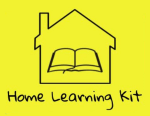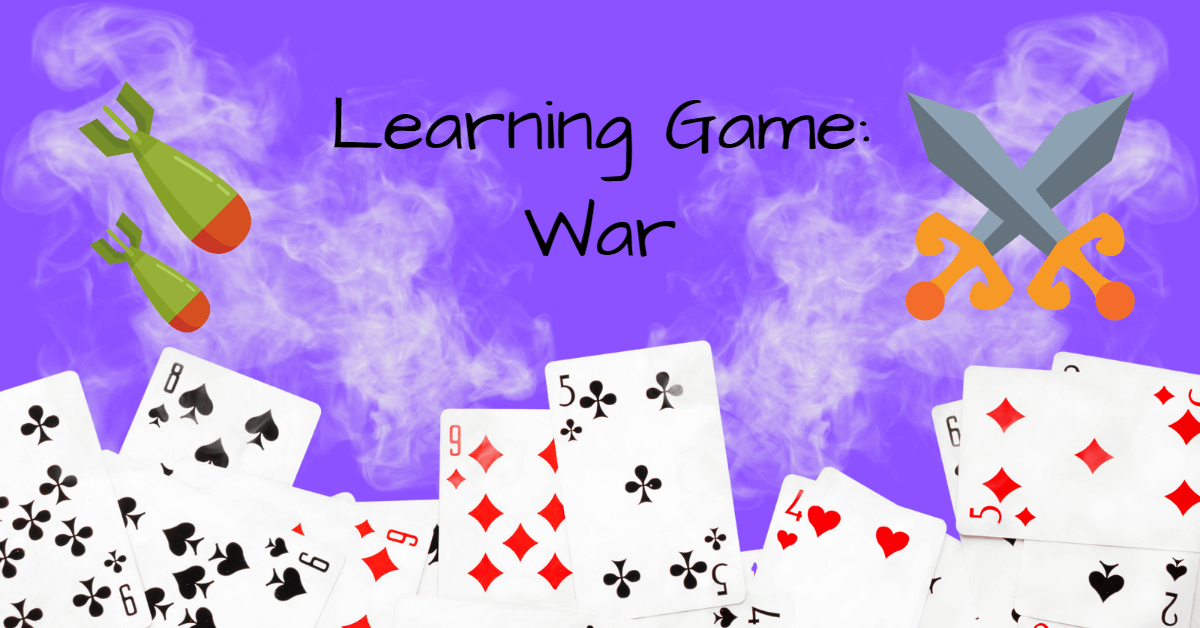Every kid loves to play the card game ‘War’, but did you know that it can be educational as a War Learning Game? Below, I’ll provide a summary of the basic game plus some fun grade level variations you can use with your kids to practice additional math skills.
How to Play War
If you’re unfamiliar, ‘War’ is a two player comparison card game. Each player gets half the deck and flips their top card to be compared against that of the other player. The player with the high card wins and takes both cards in play!
If there’s a tie, it means War! Each player places one face down card and then one face up card to compare. The winner takes the whole stack of six cards.
The game ends when one player takes all the cards.
How to Play the War Learning Game
My critical thinkers out there probably see how this learning game will reinforce math for your kids: Identifying numbers, counting, and understanding number order practiced in a fun, competitive way.
But ‘War’ can be used for a lot more than just the basics. Check out the adjustments you can make for each grade level to spice things up!
Kindergarten
You’re going to keep it basic here. Even more simple than the regular game. Start playing with just one (ace) through five. You can jump up to one through ten when your kiddo is ready.
Remember, you should encourage your child to use the icons on the card to count if they’re having trouble making the comparisons.
First Grade
At this level, your child should have a good grasp of playing with one through ten in the deck. If they still need to practice it, don’t worry. Just keep playing and they’ll get it down. When they’re solid with one through ten, you can introduce Jacks, Queens, and Kings as 11, 12, and 13, respectively.
Variation 1: You’re going to use ‘War’ to practice addition with one through ten. Take one of your jokers and put a sticky note on it with a ‘+’. Instead of playing one card at a time, you’re going to play two cards each and add them together. If you have a tie, play two more each. If your child is comfortable with this, you can try adding 11, 12, and 13 to the game.
Variation 2: Next, we’re going to mosey over to subtraction skills. Same deal as Variation 1, except you’ll have a ‘-‘ sign on the joker. Don’t worry about working left to right on your subtraction problems. Just subtract the smaller number from the bigger number.
Your 6 year old’s brain might explode if you start messing around with negative numbers. This is a learning game, not torture!

Second & Third Grades
By now, hopefully your child has a solid grasp on basic addition and subtraction with two numbers and is familiar with the values for Jacks, Queens, and Kings. The next variation will get them some practice working with extended math problems and higher numbers.
Variation 3: Now, you’re going to be using all the cards in the deck, as well as a joker with a ‘+’ or ‘-‘ on it. But this time you’re doing three cards instead of just two.
This can get a little tricky with the subtraction problems, because it’s easy to drop into negatives when subtracting twice. If your child is ready for it, this can be a good way to start working with negative numbers (although it’s still a bit early according to a lot of curricula). If you don’t want to do negative numbers yet, just replay the hands where they happen.
Also, you can combine your addition and subtraction problems here. Try adding the first numbers and subtracting the third, or vice versa!
Fourth Grade and Up
At this point, your child will be working on multiplication and division problems in their regular homeschool classes, and you can use ‘War’ to get some extra practice.
Variation 4: Use all the cards in the deck and replace your ‘+’ and ‘-‘ jokers with ‘x’ and ‘÷‘. Stick with two cards unless you want to start doing written multiplication and long division.
Division problems will regularly end up with fractions/decimals, so make sure your child has some exposure to working with them, or you won’t have a very fun game.
Additional Variations: The above covers the basics, but there’s even more ways challenge your child. For example, combine multiplication, division, addition, and subtraction operations using three or four cards. This could provide some practice with the Order of Operations (PEMDAS).
Wrapping Up
The War Learning Game will help your homeschooler practice their math skills in a fun and competitive environment. After all, as a homeschool parent you know that learning doesn’t have to be stuck in a structured lesson. Maybe it’ll help you brush up on the basics too!
I’m sure you probably have a deck of cards at home, but if you could use a new deck or want one just for lessons with your kids, I have a solution for you! The Home Learning Kit is a curated package of educational tools to make your homeschool more fun and engaging, and it includes cards too!

The Home Learning Kit
Simplify your homeschool prep with a package of tools and resources to help make your homeschool more fun and engaging.
Want more? I have more learning games for you to discover here!
I’d love to hear what other learning games you play with your kids! Tell me how it’s going on social media!

